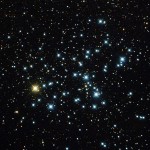
Seven years of meticulous observing have resulted in a cosmic discovery that comes from an era dating back 13.1 billion years, giving scientists a detailed glimpse of what may have happened just after the Big Bang.
Using the world-class W. M. Keck Observatory on Maunakea, Hawaii, an international team of astronomers from the United States, Australia, and Europe has confirmed the existence of one of the most distant galaxies in the universe.
To characterize the faint galaxy, the discovery team, led by Austin Hoag, a University of California, Davis physics graduate student, used MOSFIRE, the most in-demand instrument on the 10-meter Keck I telescope.
What makes this galaxy extraordinary is that it is ordinary. It is thought to be a common galaxy at that distance and age of the universe. However, such galaxies would normally be too faint to detect. The astronomers used a method called gravitational lensing to magnify the galaxy so they could study it.
“Most objects that we’ve seen at that distance are extremely bright, and probably rare compared to other galaxies,” said Hoag. “We think this galaxy is much more representative of other galaxies of its time.”
Continue reading “Primordial Galaxy Discovered, First of Its Kind”







